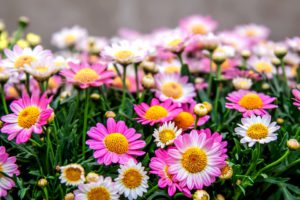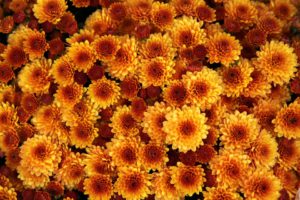How to Grow and Care for Chrysanthemums

A popular garden flowering plant that is so easy to grow and care for our chrysanthemums, chrysanthemums are sometimes called mums. There are hundreds of varieties of these garden beauties which you can find in many shapes and sizes. Native to northeastern Europe and Asia chrysanthemums will give color blooms that make both your outdoor gardens and interior inviting.
History records that chrysanthemums were first cultivated in China as far back as the 15th century BC as a flowering herb. It’s said that “the yellow and white species of chrysanthemums are used in parts of Asia to produce a tea, used as a garnish and also added to some dishes. What is also amazing about chrysanthemums is that the flowers are crushed and the compounds are used as an active ingredient known as pyrethrins that attack the nervous system of insects causing death. Chrysanthemums have a rich history and there is much more than can be said about this garden beauty but let’s take a closer look at the growth and care of chrysanthemums.
The planting location
Chrysanthemums require a sunny location to perform their best.
The soil type
The soil type of chrysanthemums should be soil that drains well, working compost into the first top inches of the soil will help to condition your soil so chrysanthemums can thrive. When planting chrysanthemums give a spacing of 18-24 inches. This spacing will provide the proper airflow or circulation safeguarding against fungal issues.
Water requirements for chrysanthemum
The soil should be kept moist but not waterlogged, check the soil on a weekly basis to ensure that the soil is not completely dry. Applying mulch around your chrysanthemum will help to conserve water, hold weeds down and as the mulch decomposes will add nutrients to the soil.
Fertilizing chrysanthemum
During the growing seasons when your chrysanthemums are actively growing feeding them is so important. Quick-release or water-soluble fertilizers such as 15-15-15 or 20-20-20 will help greatly. Before applying fertilizers read and follow the manufacturer’s directions for best results.
Garden insect pests of chrysanthemum
Garden pests of chrysanthemums are as followed.

- Earwigs
- Aphids
- Slugs
- Snails
- Thrips
- Leaf Miners
- Mites
Earwigs
Although these garden insects help to eliminate insect pests that will destroy garden plants they too cause damage by eating parts of the plant’s leaves along with leaving behind their excrement which is black. To control earwigs the use of diatomaceous earth will offer help. Diatomaceous earth is only effective once the ground is dry, placing a ring of diatomaceous earth around your plants will give results.
Aphids
Aphids are pear-shaped and can either be black, red, yellow, green, or brown. Aphids are among the sucking insect group and will cause flowers to drop. These garden insect pests also produce a sticky substance known as honeydew. This honeydew is their excrement that causes sooty mold to form. Applying soapy water or insecticidal soap will bring aphid infestation under control.
Slugs and Snails
Slugs and Snails are among the chewing garden insect pests and dose damage by feeding on the leaves of garden plants. To bring control handpicking them and throwing them into a bucket of soapy water or applying snail bait will offer help.
Thrips
Thrips are tiny insects that can be either red, black, yellow, or dark brown. Thrips can cause serious damage because they have been known to carry viruses along with extracting the plant’s fluids causing leaf drops and failure with flower bloom. To control thrips prune or remove infected plant parts including the flowers. The use of neem oil or insecticidal soap will also eliminate them.
Leaf Miners
Leaf Miners will do damage the same as earwigs, control these garden insect pests the same as you would earwig. The use of insecticidal soap along with the removal of infected leaves will give good results.
Mites
Spider mites are very tiny, they are hard to spot but the damage of these small insects can be very server. Spider mites do damage the same as aphids with yellowing of the leaves. To test if your plant has spider mites place a white sheet of paper under the leaves and tap if spider mites are the culprit you will see tiny mites moving around on that white sheet of paper you may also feel them crawling on your hands. The presence of webbing is another sign of spider mites the use of a miticide label for spider mites will bring the infestation under control.
Disease of chrysanthemum
Identifying and treating these diseases will cause your chrysanthemum to thrive.
- Blights
- Rust
- Molds
- Leaf spot disease
- Powdery mildew
Rust
Garden plants that are severely infected by this disease will be stunted while the leaves will shrivel up and die. Pale yellow spots will also develop on the upper leaf surface that is infected, lumpy spores pustules will develop on the undersides of leaves. This disease is spread by airborne spores. Control measure includes the removal of infected plant parts along with applications of fungicides that are labeled to eliminate this disease. If the entire plant is severely infected by this disease it’s best to dispose of it.
Molds
This disease is caused by poor air circulation and environmental conditions, signs include leaves with lesions that are brown which also affect the flower bloom. Gray areas that are moldy will also be seen. The leaves may also develop sooty spots that are black, bring this disease under control by providing proper air circulation, removing infected plant parts, and reducing moisture.
Blights
Symptoms of botrytis blight include stems and leaves turning brown along with buds that are affected. This disease is spread by splashing water, a moldy substance may appear on plant parts also lesions that are brown and moist may appear. Hot weather will add to this issue, the use of a fungicide that contains chlorothalonil will bring control. The removal of infected plant parts will offer help also.
Leaf spot disease
The symptoms of leaf spots include the appearance of spots that turns from yellow, brown, and then black, killing the leaf. Water splashing from diseased plants onto healthy plants encourages this disease. The use of a fungicide that contains chlorothalonil will bring control. The removal of infected plant parts will offer help also.
Powdery Mildew
Powdery mildew is a white powder-like substance that appears on the leaves of garden plants, this disease is caused by poor air circulation and weather that are very humid. To bring this disease under control make sure that garden plants have the right spacing for proper airflow, the use of a fungicide that is labeled for this disease will bring under control.
Some ideas to place your chrysanthemum
Place chrysanthemums in these areas for beautification.
1. Install chrysanthemums in your garden plant beds.
2. Install them as border plants.
3. Plant chrysanthemums alongside your garden path walkway.
4. Install alongside your fence area.
5. Place an arrangement of daisies alongside your wall.
6. Place chrysanthemums in containers and place the containers on either side of your main door entrance.
7. Place containers with chrysanthemums on your patio.
8. Plant chrysanthemums around the trunk of trees provided they are getting sufficient sunlight.
9. Install in a container on your balcony.
10. Your Terrance makes a good location.
Growing chrysanthemum in containers
Chose a container large enough for your chrysanthemums to sit comfortably, the container should have holes for water drainage. The soil should be a well-drain loamy garden soil, a soil of this type will hold the right amount of moisture but will allow excess water to drain through.
The container should be placed in an area that gets full sunlight, keeping the soil moist not waterlogged is so important for your chrysanthemum to grow healthy. Fertilize and keep an eye out for disease and garden pests as discussed earlier and treat accordingly. Fertilize your chrysanthemums before the flower buds form, this feeding will encourage chrysanthemums to grow vigorous and healthy.
The growth and care of chrysanthemum indoor
When growing chrysanthemums indoors place them in an area that gets bright sunlight. Ensure that the soil is somewhat moist and not waterlogged. When watering apply the water directly to the soil, and avoid wetting the foliage or leaves that will encourage fungus. Avoiding excess humidity and encouraging good air circulation is a must so ensure that your mums have these requirements met also. Fertilize during the growing season but once the colder months approach, discontinue feeding.
Deadheading chrysanthemum
Deadhead your chrysanthemums by removing spent or faded flowers, this process will take your chrysanthemums through a rejuvenation period in which your chrysanthemums will produce more foliage and flowers. When removing flowers that are faded a hand pruner is the right tool for the job.
Pinching the new growth back to about 6 inches in the spring will promote new branch growth. Once faded flowers are removed you will have to wait a while for new blooms to appear but once chrysanthemums start to bloom again you will have an abundance of flowers.
The final word
Installing chrysanthemums in your garden and landscape will give you just what you are looking for these garden beauties are popular and have made a name for themselves showing that they will go to work for you to get the job done. Chrysanthemums are used in many garden and landscape designs, give them a try and watch as they bloom so beautifully.
About the author
Norman loves being in the garden, both at home and for his job....
he is 'Natures Little helper' being outdoors, growing his vegetables and flowers from an early age.
Now having spent over 22 years in the profession he want to give some of his knowledge to others...
his vast array of hints and tips you will find scattered over this site will help you no end growing plants in your garden.
